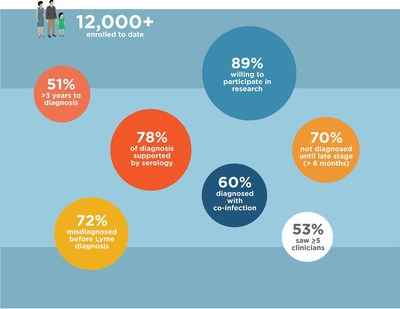Prompt diagnosis is key to preventing patients from developing chronic Lyme disease

LOS ANGELES, May 1, 2019 /PRNewswire/ — Failure to recognize and treat Lyme disease in its early, acute phase is one of the biggest factors leading to long-term persistent illness. That’s a principal conclusion of LymeDisease.org’s 2019 Highlights Report for the MyLymeData Patient Registry, released today.

Over 12,000 people who have been diagnosed with Lyme disease are enrolled in the registry. Most of these patients have the persistent or chronic form of the illness. Lyme disease, spread primarily through the bite of a tick, is most effectively treated in the first month, before the infection has spread.
According to Lorraine Johnson, CEO of LymeDisease.org and Principal Investigator of MyLymeData, although early antibiotic treatment failures occur too often, the larger problem is that too many patients aren’t diagnosed and treated soon enough.
“Seventy percent of patients with late or chronic Lyme disease are not diagnosed until six months or more after symptom onset. Yet, no one has researched the best way to treat this population. Protocols developed for acute disease do not appear to be effective. We need better treatments for late-stage, untreated Lyme disease,” Johnson said.
Only 12% of patients in the registry were diagnosed within the critical first month. Patients who are not diagnosed early often develop serious, chronic symptoms such as cognitive impairment, severe joint pain, headache, and fatigue.
The report analyzes the data from 3,903 patient enrolled in Phase 1 of the Registry. Other important conclusions from the Highlights report include:
- 70% of those in the registry were not diagnosed until six months or more following the onset of their symptoms. Most patients take three or more years to diagnosis and see five or more clinicians. Patients diagnosed late are less responsive to short-term antibiotic treatment.
- Fewer than 12% of patients in the registry were diagnosed within the critical first month. Most patients who are diagnosed and treated early respond well to short term treatment protocols.
- 74% reported early symptoms of the disease, but only 34% recall having the distinctive erythema migrans rash (EM) commonly relied on by physicians for diagnosis. More common early symptoms were flu-like symptoms (64%) and severe head-ache or stiff neck (44%). Patients who do not have an EM rash are more likely to be misdiagnosed.
- 60% report that they have been diagnosed with an additional tick-borne infection, such as Babesia or Ehrlichia. The presence of co-infections may increase the likelihood of developing chronic Lyme disease.
- 72% of patients with chronic Lyme disease report that they were initially misdiagnosed with another condition. Patients misdiagnosed with another condition experience diagnostic delays and may be exposed to adverse effects from treatments for diseases that they do not have.
Patients who develop acute Lyme disease and are treated promptly have a good chance of getting well. Shortening the time to diagnosis and providing early treatment could prevent many patients from developing chronic Lyme disease, Johnson said.
“It’s critical to identify why Lyme disease patients are not being diagnosed early, to shorten the time to diagnosis and to develop better treatments for patients diagnosed late,” Johnson said. “We’re hoping MyLymeData will help us to reach that goal.”
Many of the data points highlighted in the report were previously unknown to the community because so little real-world research on Lyme disease has been conducted.
About LymeDisease.org
LymeDisease.org’s mission is to empower patients through science-based advocacy by educating them, amplifying their collective voice, and providing big data research tools like our MyLymeData patient registry. We believe that there is strength in numbers.
About MyLymeData
MyLymeData is a patient driven research platform and registry. It uses big data research tools that allow patients to pool their data quickly and privately to determine which treatments work best. Over 12,000 patients have enrolled in the registry, which is now in the top 5% of patient-driven registries in the nation. MyLymeData has collected over 2 million data points and is now an important and irreplaceable source of information about Lyme disease that will continue to grow. MyLymeData is a testament to what patients can achieve when they pool their data to help find a cure.
Additional Resources
This report can be downloaded here.
To enroll in MyLymeData, visit www.MyLymeData.org.
For more information about findings from the registry, visit the MyLymeData Viz Blog.
|
Contact: |
Lorraine Johnson, JD, MBA |
|
Email: |
|
|
Phone: |
323-207-8526 |

View original content to download multimedia:http://www.prnewswire.com/news-releases/prompt-diagnosis-is-key-to-preventing-patients-from-developing-chronic-lyme-disease-300841499.html
SOURCE LymeDisease.org
